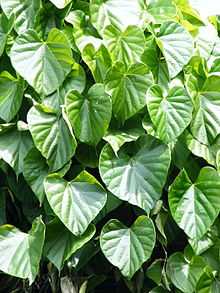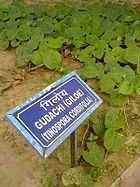Tinospora cordifolia
| Tinospora cordifolia | |
|---|---|
 | |
| Scientific classification | |
| Kingdom: | Plantae |
| (unranked): | Angiosperms |
| (unranked): | Eudicots |
| Order: | Ranunculales |
| Family: | Menispermaceae |
| Genus: | Tinospora |
| Species: | T. cordifolia |
| Binomial name | |
| Tinospora cordifolia (Thunb.) Miers | |
Tinospora cordifolia, which is known by the common names Guduchi and Giloy, is an herbaceous vine of the family Menispermaceae indigenous to the tropical areas of India, Myanmar and Sri Lanka.
The plant is a glabrous climbing shrub found throughout India, typically growing in deciduous and dry forests. The leaves are heart shaped. The succulent bark is creamy white to grey in color, with deep clefts spotted with lenticels. It puts out long, slender aerial roots, and is often grown on mango or neem trees.[1] Flowers are yellow, growing in lax racemes from nodes on old wood. Fruits are drupes, turning red when ripe.[2]
Constituents
The active adaptogenic constituents are diterpene compounds, polyphenols, and polysaccharides, including arabinogalactan polysaccharide.[3][4]
In herbal medicine

According to the 1918 United States Dispensatory, the plant has a long history of use in India as a medicine and in the preparation of a starch known as Giloe-ka-sat or as Palo.[5] Tinospora cordifolia and related species such as Tinospora crispa and Tinospora rumphii Boerl are used in Ayurvedic and Jamu herbal medicine.
In Ayurvedic use
In Ayurveda, Guduchi is considered one of the most divine herbs.[6]
Research
A standardized extract from Tinospora known as Tinofend has been studied clinically. One study in 75 patients with allergic rhinitis (hay fever) showed statistically significant reduction of symptoms compared to placebo.[7] An independent review of this study concluded that "significant intergroup differences were seen in all symptoms", although studies in larger populations may support this finding.[8]
Common names
There are many common names for this species in different languages. Punjabi: گلو (Gllow) Telugu: తిప్ప తీగ (Tippa-teega), Tamil: சீந்தில் கொடி (Shindilakodi), Malayalam: ചിറ്റമൃത് (Amruthu, Chittamruthu), Kannada: ಅಮೃತ ಬಳ್ಳಿ (Amrutha balli),[9] Khmer: បណ្តូលពេជ្រ (bândaul pich) Sinhala: Rasakinda, Thai: บอระเพ็ด (boraphét) Hindi:geloy (गिलोय), guruc (गुरुच), gurcha, Gujarati: galac, garo, Sanskrit: Amritavalli (अमृतवल्ली), amrta (अमृत), cinnodbhava (छिन्नोद्भवा), Marathi: Guduchi (गुडूची), gulvel (गुळवेल) Oriya: Guluchi, Myanmar: ဆင်တုံးမနွယ် Nepali: Gurjo (गुर्जो)
References
- ↑ Wagner, Hildebert (1999). Immunomodulatory agents from plants. Birkhäuser. p. 294. ISBN 978-3-7643-5848-8.
- ↑ Warrier, P. K.; V. P. K. Nambiar; C. Ramankutty; R. Vasudevan Nair (1996). Indian medicinal plants: a compendium of 500 species, Volume 5. Orient Blackswan. p. 283. ISBN 9788125007630.
- ↑ Winston, David & Maimes, Steven (2007). Adaptogens: Herbs for Strength, Stamina, and Stress Relief. Healing Arts Press.
- ↑ S.S. Singh, S.C. Pandey, S. Srivastava, V.S. Gupta, B. Patro, A.C. Ghosh (2003). "Chemistry and medicinal properties of Tinospora cordifolia" (PDF). Indian Journal of Pharmacology 35: 83–91.
- ↑ Tinospora. Tinospora cordifolia. | Henriette's Herbal Homepage
- ↑ National R&D Facility for Rasayana
- ↑ Badar, VA; Thawani, VR; Wakode, PT; Shrivastava, MP; Gharpure, KJ; Hingorani, LL; Khiyani, RM (2005). "Efficacy of Tinospora cordifolia in allergic rhinitis". Journal of Ethnopharmacology 96 (3): 445–9. doi:10.1016/j.jep.2004.09.034. PMID 15619563.
- ↑ Guo, R; Pittler, MH; Ernst, E (2007). "Herbal medicines for the treatment of allergic rhinitis: A systematic review". Annals of Allergy, Asthma & Immunology 99 (6): 483–95. doi:10.1016/S1081-1206(10)60375-4. PMID 18219828.
- ↑ Ethnobotanical Leaflets
External links
- Caldecott, Todd (2006). Ayurveda: The Divine Science of Life. Elsevier/Mosby. ISBN 0-7234-3410-7. Contains a detailed monograph on Tinospora cordifolia (Guduchi) as well as a discussion of health benefits and usage in clinical practice. Available online at http://www.toddcaldecott.com/index.php/herbs/learning-herbs/364-guduchi
- http://www.ayurvedacollege.com/articles/students/Guduchi Guduchi: The one who protects the body